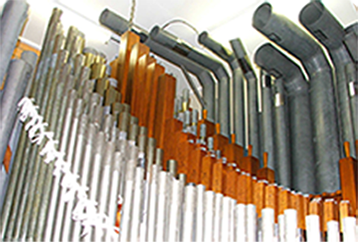Newark Symphony Hall
1030 Broad Street, Newark, N.J.
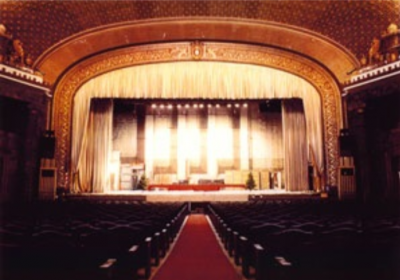
Inside the Sarah Vaughan Concert Hall at Newark Symphony Hall
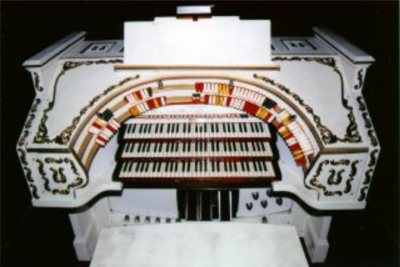
Marr and Colton Console connected to the Griffith-Beach Organ
Re-dedication
The re-dedication concert for this organ was held on Saturday November 10, 2001 with 200 people in attendance. Organist Ralph Ringstad, Jr. accompanied the silent film, “Steamboat Bill Jr.”, and presented a 1 hour concert. This theatre pipe organ is owned by the theatre, but continues to be maintained by a volunteer group of GSTOS members.
History of the Venue
Newark Symphony Hall was formerly the Mosque Theatre. This large beautiful building was built in 1925 by the Ancient Order of Nobles of the Mystic Shrine (known as the Shriners). It is listed on the National Register of Historic places. The interior of the Sarah Vaughan Concert Hall is very impressive, it contains 2,880 seats and a 3 manual 15 rank Griffith-Beach Theatre Pipe Organ. Through the years, the theatre has been an art center and some of the greatest musicians, singers and dancers have and still are performing there. Acoustically, the building is considered to be one of the finest concert halls in the east coast.
Unfortunately some years ago, the 4 manual Griffith-Beach console cable was cut and the console removed. The pipes were left in the chambers. A picture of the original console appears on pg. 154 of Junchen’s Encyclopedia of the American Theatre Organ Vol. 1 In the picture someone wrote “Save Me” with their finger in the dust on the console. We had the privilege of restoring this instrument and installing a 3 manual Marr and Colton replacement console.
A Restoration Story
In 1920, local New Jersey organ builder Earle Beach installed a 4 manual 15 rank theatre pipe organ in the Salaam Shrine Temple on Broad Street in Newark. The 2800 seat Temple was later to be called the Mosque Theatre, and today is known as Newark Symphony Hall. Specializing in consoles, Beach had been a one time employee of Robert Hope Jones when he was building the Ocean Grove organ and various theatre, school and lodge organs in our area. Striking out on his own, Beach received financial backing from the Griffiths,noted local piano and music dealers. The Griffith showroom was on the west side of Broad Street in central Newark, and was in operation at least into the 1960’s. The abandoned building is still there with the name engraved in the facade. Thus, the Griffith-Beach organ company was born.
It appears that Beach fabricated his own consoles and bought most other parts from a variety of manufacturers. To my knowledge, there are only three remaining Griffith-Beach theatre organs in operation today: the 3/24 in my home that has now gone to the Tioga Theatre, Owego, N.Y. (salvaged from the Masonic Temple in Elizabeth), the organ at St.Jude’s RC Church, Lake Hopatcong (salvaged from a high school in Newark), and due to our efforts, the original installation at Newark Symphony Hall. In 1987 the Newark theatre was slated to get a complete redecoration job, and I decided to explore a rumor I had heard years before that there was an organ there. I met with the long time maintenance supervisor, and he told me that the cable had been cut and the console removed in the 1950’s, but the organ was still intact.
We explored the chambers, and much to my amazement the instrument looked in great shape except for years of dirt, a missing bass drum, and one missing 16′ tuba pipe. The blower room revealed 2 kinetic blowers, a main and a spare. We threw the blower switch on. Nothing happened. The old maintenance man then licked his fingers, momentarily touched the 220 input and said “no power”. (Do NOT try this yourself, kids, you will be DEAD!!). We then decided to examine the electrical panels in the boiler room. One was labeled “organ”, but was clearly hooked up to an old abandoned boiler. Opening the electrical panel, the maintenance man found three loose wires. He hooked them up to the bus bars and we returned to the blower room. A flip of the switch and the #1 blower came to life after decades of sleep!!
Expecting to hear a great many ciphers, I was surprised to find that only 1 or 2 pipes sounded. Entering the theatre proper, we heard a great rushing of wind. Upon further investigation it was determined that a joint had separated in the wind line which runs over the top of the proscenium between chambers. I made arrangements to do a temporary repair, and returned with Pete Polito, Jim Donald, and Fred Portz to fix the wind leak. The leak was fixed, but during the repair I fell ill and ended up in the emergency room with a heart problem. Grounded, I thought that any hopes of ever hearing the organ play were all but shattered. About 10 years later, I had learned to live with my mostly healed heart, and in the meanwhile had built the music room in my home and had fun installing the 3/24 Griffith-Beach from the Elizabeth Masonic Temple there. Cathy, my wife, was now President of GSTOS and brought up the Newark organ. We went to the hall and talked to the present operators, who had to be convinced that they owned a theatre pipe organ. Only by actually climbing the chamber ladders were they made aware of their hidden treasure!
It wasn’t long before GSTOS had a contract to restore the organ. Jack Decker, Tom Sarkauskas, Ron Valencourt and I formed the initial crew. We discovered that someone had walked on the proscenium wind line, and the entire line had to be replaced. Then we dropped a few bottom boards from the wind chests and discovered that there had been a roof leak in one section of the solo chamber and quite a bit of releathering had to be done. The original pneumatic relay was kept and releathered. I would estimate that 2/3 of the leather in the organ has now been replaced.We also had to refurbish a number of the percussions. While snooping around one day, I opened a hatch door in the main theatre colonnade and, to my surprise, there was the missing 16′ tuba pipe!!
As work progressed, we picked up some more dedicated crew members: Mike Fox, Ralph Ringstad, Sr., Joe Vanore, Bill Londell and Ralph Ringstad, Jr. A 3 manual Marr and Colton french style theatre console was donated by Barbara Reynolds, from the estate of her brother, former GSTOS member Don Plenkers. Its original home was the Dyker Theatre in Brooklyn. This console was missing the pedalboard, but we were able to utilize the one that came with the old original Beach console in my home. We refinished the console in antique white, with our gilder,crew member Jinny Vanore, restoring the gold ormolu decorations. The original 4 manual setup was respecified to 3, basically retaining the original Solo and Accompaniment manuals, and combining the middle keyboards into a new Great manual. Electric stop switches and new engraved stop tabs were installed along with new wiring. An Emutek multiplexing system, enabling a small wire connection to the oldrelay was added, thus making the console moveable. The original console location was in the center of the orchestra pit.
The new console works well on the stage for concerts, but is not usable for playing silent movies in that location. Plans are to place it in the pit on tracks, so it can be safely slid under the stage when not in use, and easily moved out front for playing. The organ is well situated for the excellent acoustics of the room, speaking from the top corners of the proscenium and into the circular dome with its crystal chandelier. The instrumentproduces a very “big” sound! The NJ Symphony Orchestra and Opera Company rehearse in the theatre because of the excellent acoustics, and we are looking forward to doing an organ concert with the symphony.
Silent for over 50 years, the organ was first heard in public on Saturday, October 28, 2000 when GSTOS members shook down the instrument at an open console with theatre organ guests from upstate New York. Since its rededication in November of 2001, it has been used for a number of events, including GSTS concerts, open consoles, and a Newark high school graduation ceremony.
Bob Martin, Crew Chief
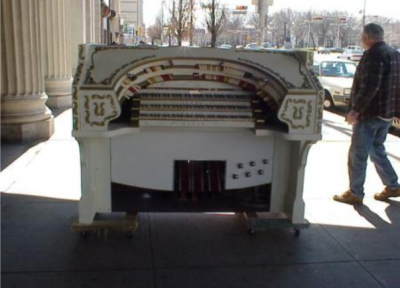
New Marr & Colton Organ Console
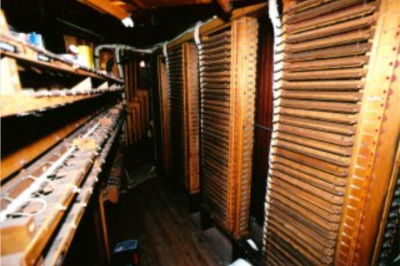
Griffith-Beach Relay
The Organ
The Griffith-Beach Organ Company built about 10 Theatre Organs in theatres in Northeastern New Jersey between 1921 and 1925. Earle Beach had worked with Robert Hope-Jones at his factory in Elmira, NY. In the early 1920s Beach formed a partnership with the Griffith Piano Company of Newark NJ. The organ in Newark Symphony Hall was installed in 1925. The Harmonic Tuba has H.J. (Hope-Jones) stamped on it.
Main Chamber / # Pipes
16′ Diaphonic Diapason / 85
8′ Viole d’ Orchestre / 85
8′ Clarinet / 61
8′ Orchestral Oboe / 61
‘ Violin Celeste / 73
16′ Concert Flute / 101
8’ Tibia Plena / 73
Marimba / 37
Metal Harp / 37
Griffith Beach electro-pneumatic relay + Emutek combination action and multiplexer
Blower: Kinetic, style 3JYSPEC (plus spare), 1750 rpm, 1700cpm at 8″, 300cfm at 15″
Solo Chamber / # Pipes
16′ Harmonic Tuba (H.J. stamped) / 85
16′ Tibia Clausa / 101
8′ French Horn / 61
8′ Open Diapason / 73
8′ Vox Humana / 61
8′ Violin d’ Gamba / 73
8′ Violin d’ Gamba Celeste / 73
8′ Kinura / 61
Xylophone / 37
Orch. Bells / Glockenspiel / 37
Chimes / 25
All traps / sound effects
Piano – There may have also been a piano connected at one time. (Based on organist William Meeder’s notes and a relay label)
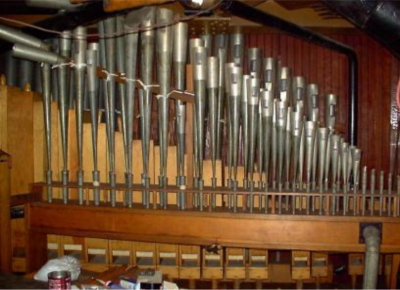
Solo Chamber
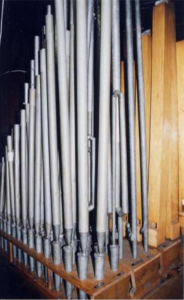
Main Chamber
Respecified Console Layout
Pedal
32′ Bourdon Resultant
16′ Harmonic Tuba
16′ Diaphonic Diapason
16′ Tibia Clausa
16′ Bourdon
8′ Trumpet (prepared)
8′ Harmonic Tuba
8′ Diaphonic Diapason
8′ Open Diapason
8′ Tibia Plena
8′ Tibia Clausa
8′ Gamba Celeste II
8′ Viole Celeste II
4′ Diapason
8 Acc to Pedal
8 Great to Pedal
8 Solo to Pedal
Bass Drum
Kettle Drum
Cymbal
Triangle
Accomp
16′ Viole d’ Orchestre
16′ Viole Celeste
16′ Bourdon Tibia
8′ Diaphonic Diapason
8′ Tibia Plena
8′ Orchestral Oboe
8′ Clarinet
8′ Viole d’ Orchestre
8′ Viole Celeste
8′ Concert Flute
4′ Diaphonic Diapason
4′ Tibia Plena
4′ Viole d’ Orchestre
4′ Viole Celeste
4′ Concert Flute
8′ Metal Harp
4′ Acc to Acc
8 Solo to Acc
Tom Tom
Woodblock
Tambourine
Castanets
Snare Drum Strike
Snare Drum Roll
Great
16′ Trumpet (prepared)
16′ Harmonic Tuba
16′ Diaphonic Diapason
16′ Tibia Clausa
16 Gamba (T.C.)
16 Viole d’ Orchestre (T.C.)
16′ Bourdon
8′ Trumpet (prepared)
8′ Harmonic Tuba
8′ Diaphonic Diapason
8′ Open Diapason
8′ Tibia Plena
8′ Tibia Clausa
8′ French Horn
8′ Orchestral Oboe
8′ Kinura
8′ Clarinet
8′ Gamba
8′ Gamba Celeste
8′ Viole d’ Orchestre
8′ Viole Celeste
8′ Concert Flute
8′ Vox Humana
4′ Tuba Clarion
4′ Diapason Octave
4′ Open Diapason
4′ Tibia Plena
4′ Tibia Clausa
4′ Gamba
4′ Gamba Celeste
4′ Viole d’ Orchestre
4′ Viole Celeste
4′ Concert Flute
2 2/3′ Flute Twelfth
2′ Viole Fifteenth
2′ Flute Piccolo
1 3/5 Flute Tierce
8′ Marimba
4′ Xylophone
4′ Orch Bells
4′ Glockenspiel
16′ Great to Great
8′ Great Unison Off
4′ Great to Great
16′ Solo to Great
8′ Solo to Great
4′ Solo to Great
Solo
16′ Harmonic Tuba
16′ Tibia Clausa
16′ Gamba (T.C.)
16′ Gamba Celeste (T.C.)
8′ Trumpet (prepared)
8′ Harmonic Tuba
8′ Open Diapason
8′ Tibia Clausa
8′ French Horn
8′ Kinura
8′ Gamba
8′ Gamba Celeste
8′ Vox Humana
4′ Tuba Clarion
4′ Open Diapason
4′ Tibia Clausa
4′ Gamba
4′ Gamba Celeste
3 1/5′ Tibia Tenth
2 2/3′ Tibia Twelfth
2′ Tibia Picoolo
1 3/5′ Tibia Tierce
8′ Metal Harp
8′ Marimba
8′ Xylophone
4′ Orch Bells
4′ Glockenspiel
8′ Chimes
16′ Solo to Solo
4′ Solo to Solo
Tremulants
Main
Solo
Harmonic Tuba
Combination Action
General: 1 2 3 4 5 0
Acc/Ped: 1 2 3 4 5
Gt/Solo: 1 2 3 4 5
Set
Expression Pedals
Main (with indicator)
Solo (with indicator)
Crescendo (14 stage with indicator)
Toe Studs
Bird
Boat Horn
Cow Bell
Triangle
Bass Drum
Crash Cymbal
Siren
Auto Horn
Great Sustain
Great Sostenuto
Sforzando
Tutti
Zymbelstern






